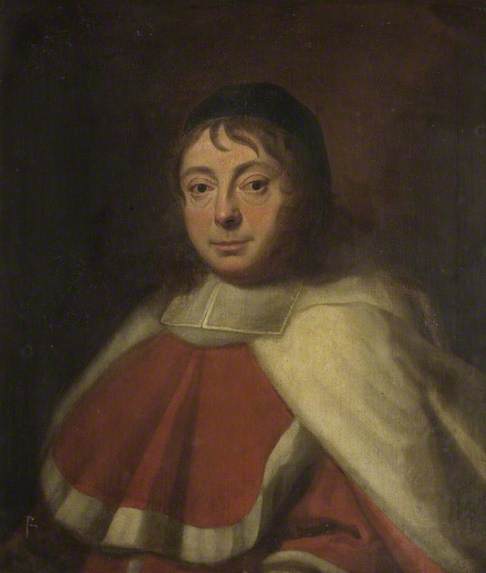Completed Dress and Textiles, Portraits: British 16th and 17th C, South West England: Artists and Subjects 19 comments Who might be this 17th Century judge?

Photo credit: Somerset County Council
The sitter is dressed in the robes of a 17th century judge, as here https://bit.ly/3y0iHsh and https://bit.ly/3hYPQPy
Completed, Outcome
This discussion is now closed. The title has been updated from ‘Portrait of an Unknown Judge’ to ‘Sir Thomas Street (1625–1696), MP, KB, JP’, and a probable date added of 1670s.
Thank you to everyone who contributed to the discussion. To anyone viewing this discussion for the first time, please see below for all the comments that led to this conclusion.
18 comments
The Collection has commented: ‘Here is a copy of our comments from our research into the SCC collections here. We are afraid it adds nothing much to what you have already and as its provenance is unknown it may not be a Somerset man.
‘Painted portrait of a judge by an unknown artist, oil on canvas, displayed in a gilt frame. The unknown man is shown seated from the waist up against a plain background. He wears the red robes and plain bands of a judge of the mid 17th Century with a skullcap over his natural hair. The painting probably dates to around 1630-1660.’’
Can one tell from the dress what kind of judge he was, or at what level, or in what location? Based on the similarity of dress to that of the two judges linked above, he must have been a person of some importance.
If nothing else, this picture should be listed under British School.
Is there a monogram at lower left?
The costume is of a late 17th century Judge and is contemporary with judges of the bloody assizes of 1685. Wikipedia has a list of 17thc judges, good place to begin research.
The hair is earlier than 1680s, and essentially the same dress was worn earlier in the century, as seen in the two examples linked above the comments section.
Jacinto, a detail of the lower left corner is attached.
Thanks, Marion. It's probably not definite enough to be a monogram; I suppose it may be a stray or extraneous mark.
We are unlikely to identify the sitter, I'm afraid, but this can certainly be listed under British School for search purposes. The current dating seems reasonable. Pending review by a Group Leader, I expect this should probably close.
Could this be a portrait of Baron Sir Thomas Street, MP, KB, JP (1625 – 1696)?
A Wikipedia page provides information about him:
http://tinyurl.com/maxbtkyw
The attached composite is based on the Art UK work, reversed, and an image on the National Portrait Gallery website (NPG D30929):
https://www.npg.org.uk/collections/search/portrait/mw140963/Sir-Thomas-Street
That is interesting, Marcie. The original 1688 engraving (also at the NPG) is http://tinyurl.com/y2n34nr9 , and it states that the engraver (Robert White) drew the sitter from life (ad vivum delin) and based the engraving on his drawing. Thus, the engraving was not after a painting. Our man looks younger, but could conceivably be Street at an earlier time, although Street was a Worcester man. However, the collection has already said the provenance is unknown and the sitter may not be a Somerset man. It would be of interest to know if Street's ODNB entry (to which I don't have access) says anything about a painted likeness.
ODNB lists these likenesses of Sir Thomas Street:
R. White, line engraving, 1688, BM, NPG
J. Instan, oils?, 1829 (after R. White), S. Antiquaries, Lond.
oils (after R. White), Inner Temple, London
oils, Harvard U., law school
I'll look at the NPG file, hopefully on Thursday.
Thank you, Jacob. If our man is Street, the painting would be no earlier than 1660s and more probably 1670s.
If our picture were after the White engraving, it would not be a reverse image and the clothing details would match more exactly, in addition to the matter of our man looking younger. But yes, it is certainly possible that our portrait is of a younger Street.
Excellent work all around. Ours is obviously a version of the portrait at Harvard. As I mentioned earlier, it can be dated as c. 1670s.
Marcie's suggestion of Sir Thomas Street (baptised 1625 – 1696) has come up trumps. There is an almost identical anon portrait at Harvard Law School. See the 1977 listing (two images) and the portrait itself (two images), all attached, from the NPG archive.
That’s an amazing document, Jacob. Thank you for your efforts.
Unfortunately, although lots of items are mentioned in the will of Sir Thomas Street (PROB 11/435/10) and that of his wife Dame Penelope Street (PROB 11/431/451), there is no mention of pictures.
The dimensions of the Harvard version (about 31 x 25 inches) are essentially the same as the dimensions of our picture.
Thank you all for this excellent outcome: the Harvard listing is a super addition to Marcie's discovery of the engraving.
